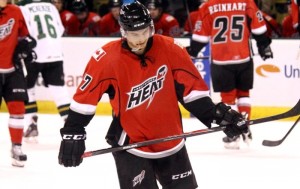In April 2009, the Calgary Flames announced the transfer of their American Hockey League affiliate from the Quad Cities to Abbotsford, British Columbia. On April 15, 2014, the Flames announced the termination of their agreement with the City of Abbotsford, ending their tenure in the Fraser Valley.

A MATCH MADE IN HEAVEN
The relationship between the Flames and the City of Abbotsford initially seemed like a perfect fit.
For the Flames, they sought stability for their AHL farm team. After re-establishing a dedicated club following the 2004-05 NHL lockout – when they shared an AHL outpost in Lowell with Carolina – their farmhands bounced from Omaha, Nebraska to Moline, Illinois. In each spot, the issue was fan support and financial stability.
For Abbotsford, they had just spent two years and the better part of $70 million of taxpayer money on the Abbotsford Entertainment and Sports Centre. The multi-purpose arena was constructed to be a jobs (and activity) creator for the Fraser Valley and to host…something.
That was the issue. They had no anchor tenant.Thus, the Flames were lured into housing their AHL team deep in Vancouver Canucks country. Arguably the biggest lure, and ultimately what soured the deal long-term, were two words: guaranteed revenue.
A MATCH MADE IN HELL
For their part, the Flames did their homework. It’s likely all sides anticipated building interest in a Flames farm team just outside of Vancouver was an uphill battle. But to ensure stability, guaranteeing the Heat’s operating revenues (at a figure around $5.7 million annually) meant that the club could focus on building interest (and a developmental club for the Flames) without having finances on their minds constantly. Reportedly, the Flames had reports commissioned on the feasibility of Heat hockey in the Fraser Valley, and were convinced they could make it work.
Only, it didn’t.
The Abbotsford Entertainment and Sports Centre holds 7,000 for hockey. The break-even point for the Heat was an average attendance level of 3,905 paid (or roughly 4,300 total tickets distributed when you factor in comps). While paid figures aren’t available for a lot of the seasons in Abbotsford – or are buried deep in the City’s website – the AHL has announced attendance figures for each of the seasons.
Here’s a list, along with estimates from the City’s website reflecting how much the Heat were paid each season to “top-up” their revenues to $5.7 million:
- 2009-10: 3,897 / $450,000
- 2010-11: 3,807 / $625,000
- 2011-12: 3,545 / $1,890,000
- 2012-13: 3,778 / $1,800,000 [projected]
- 2013-14: 3,007 / $2,000,000 [estimated]
Obviously, from a taxpayer perspective, this wasn’t sustainable. Even prior to the $5.5 million buyout given to the Flames, the Heat cost Abbotsford taxpayers roughly $7.24 million to keep afloat.
While from a hockey perspective, getting players ready for the bright lights of the NHL in front of 3,000 people per night wasn’t ideal, what was worse was the travel schedule. As the lone West Coast team in the American Hockey League, the Heat had – by far- the worst travel schedule in the league. Multi-week, multi-city and multi-game road trips were the norm. As anybody who’s traveled a lot knows, it wears on you, both mentally and physically. The team tried to manage it via giving players days off, but the combination of added travel days and added recovery days meant that the team had fewer practice days.
And for a team whose primary reason for existing is for molding Calgary’s raw prospects into NHL-ready players, “fewer practice days” is not a set of words you want to hear in their vocabulary, regardless of their necessity.
THE FUTURE
The Flames will take their $5.5 million golden handshake from the City of Abbotsford and seek out another venue for their AHL team in another city. It’s extremely likely that, no matter where they end up, it’ll be cheaper to run the team there than in Abbotsford, so the Abbotsford payout will possibly cover the first year’s expenses.
Glen Falls, NY – current home of the Adirondack Phantoms and soon to be vacant – has been rumoured as a potential new home for the Heat. As for the Abbotsford arena, the long-term plan is to find another anchor tenant (albeit probably not one that needs to be subsidized by the City).
All-in-all, the five-year Abbotsford Heat experiment will go down as a learning experience for all the parties involved. But probably not an experience either side will wish to replicate in their next ventures.